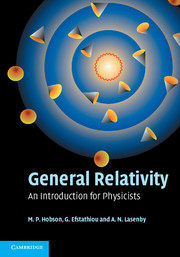Book contents
- Frontmatter
- Contents
- Preface
- 1 The spacetime of special relativity
- 2 Manifolds and coordinates
- 3 Vector calculus on manifolds
- 4 Tensor calculus on manifolds
- 5 Special relativity revisited
- 6 Electromagnetism
- 7 The equivalence principle and spacetime curvature
- 8 The gravitational field equations
- 9 The Schwarzschild geometry
- 10 Experimental tests of general relativity
- 11 Schwarzschild black holes
- 12 Further spherically symmetric geometries
- 13 The Kerr geometry
- 14 The Friedmann–Robertson–Walker geometry
- 15 Cosmological models
- 16 Inflationary cosmology
- 17 Linearised general relativity
- 18 Gravitational waves
- 19 A variational approach to general relativity
- Bibliography
- Index
19 - A variational approach to general relativity
Published online by Cambridge University Press: 05 September 2012
- Frontmatter
- Contents
- Preface
- 1 The spacetime of special relativity
- 2 Manifolds and coordinates
- 3 Vector calculus on manifolds
- 4 Tensor calculus on manifolds
- 5 Special relativity revisited
- 6 Electromagnetism
- 7 The equivalence principle and spacetime curvature
- 8 The gravitational field equations
- 9 The Schwarzschild geometry
- 10 Experimental tests of general relativity
- 11 Schwarzschild black holes
- 12 Further spherically symmetric geometries
- 13 The Kerr geometry
- 14 The Friedmann–Robertson–Walker geometry
- 15 Cosmological models
- 16 Inflationary cosmology
- 17 Linearised general relativity
- 18 Gravitational waves
- 19 A variational approach to general relativity
- Bibliography
- Index
Summary
Most of classical and quantum physics can be expressed in terms of variational principles, and it is often when written in this form that the physical meaning is most clearly understood. Moreover, once a physical theory has been written as a variational principle it is usually straightforward to identify conserved quantities, or symmetries of the system of interest, that otherwise might have been found only with considerable effort. Conversely, by demanding that the variational principle be invariant under some symmetry, one ensures that the equations of motion derived from it also respect that symmetry. In this final chapter, we therefore present an introductory account of variational principles and the Lagrangian formalism. Our ultimate aim will be to derive afresh the field equations of general relativity from this new perspective. This will require us to consider some general aspects of classical field theory in flat and curved spacetimes. As a result, this chapter lies somewhat outside the mainstream discussion presented in preceding chapters and may be omitted on a first reading. Nevertheless the variational approach that we shall outline is extremely powerful and provides the basis for most current research into the formulation of classical (and quantum) field theories, including general relativity and other candidate theories of gravitation.
Hamilton's principle in Newtonian mechanics
To begin, let us remind ourselves of a familiar example of a physical variational principle, namely Hamilton's principle in Newtonian mechanics.
- Type
- Chapter
- Information
- General RelativityAn Introduction for Physicists, pp. 524 - 554Publisher: Cambridge University PressPrint publication year: 2006



